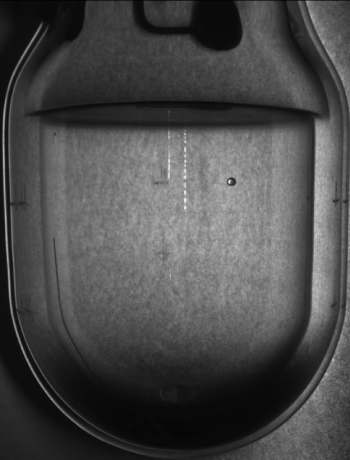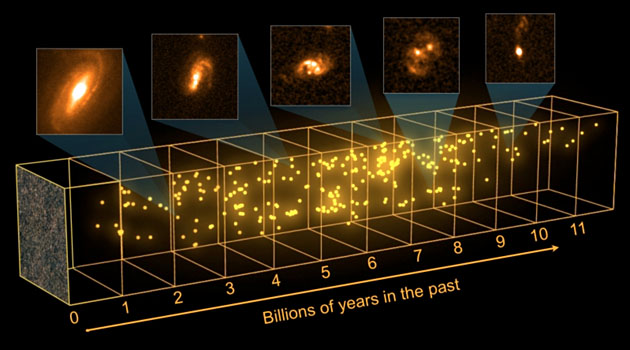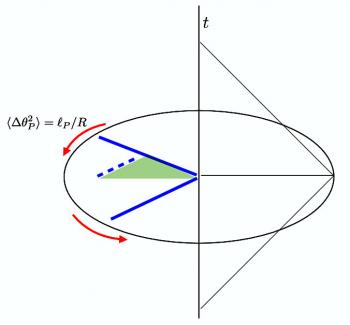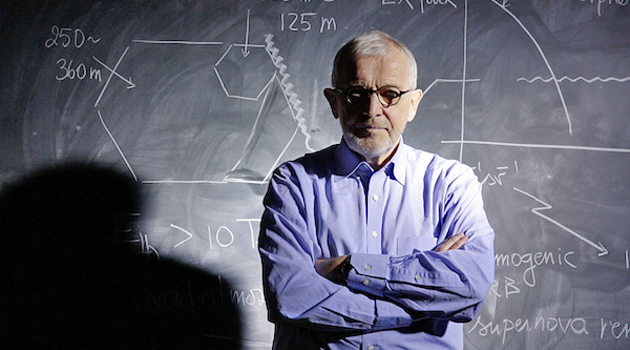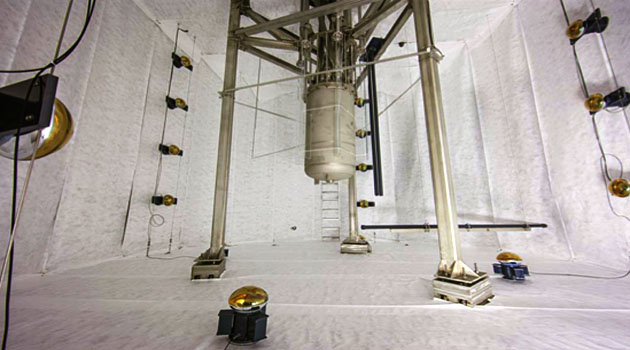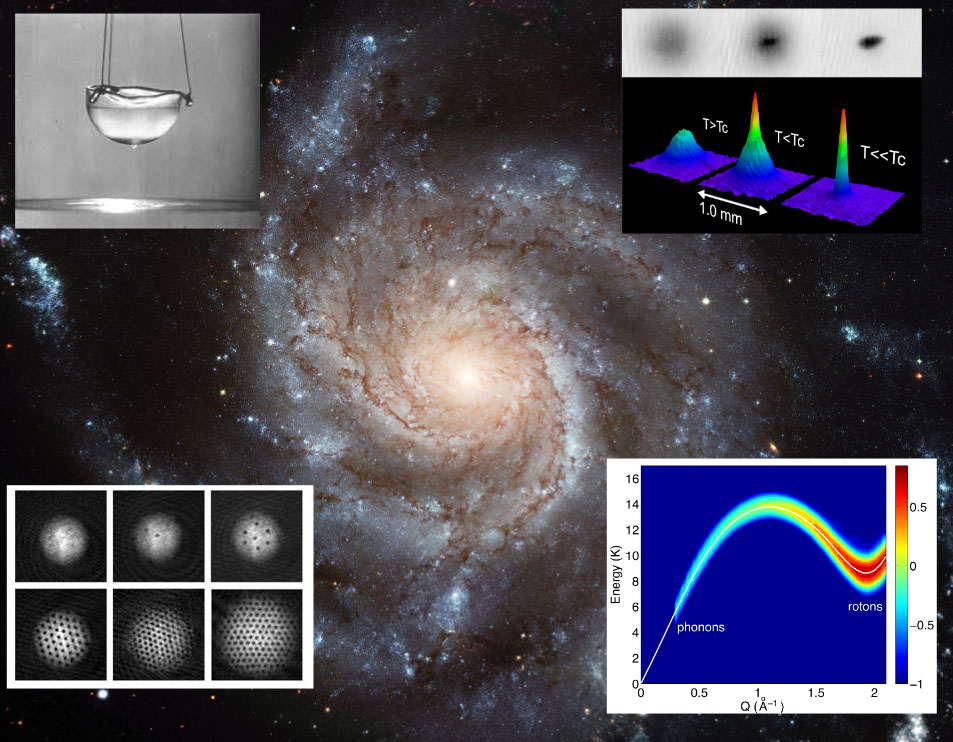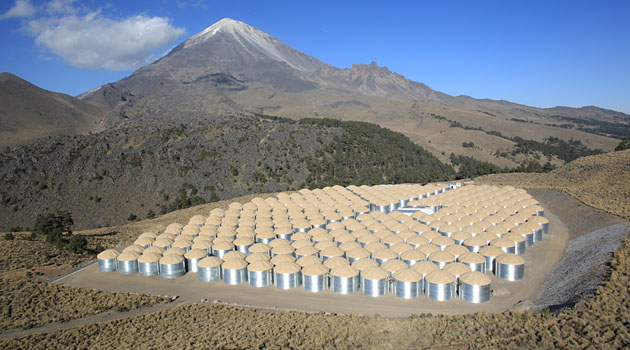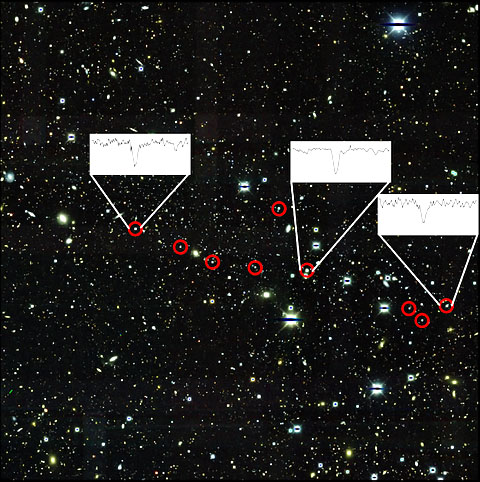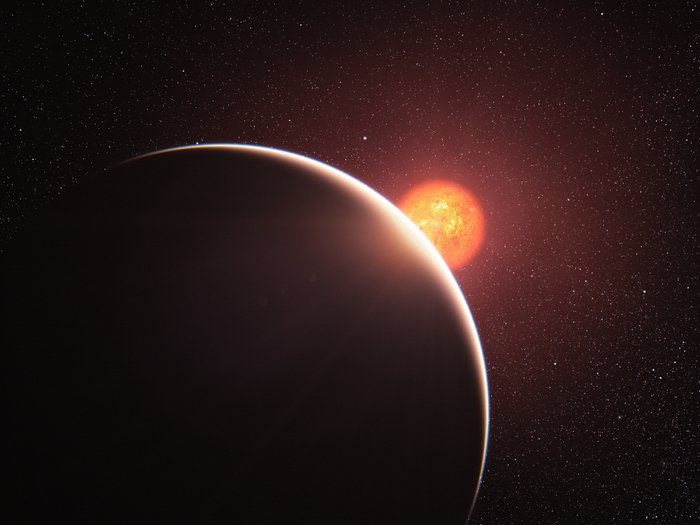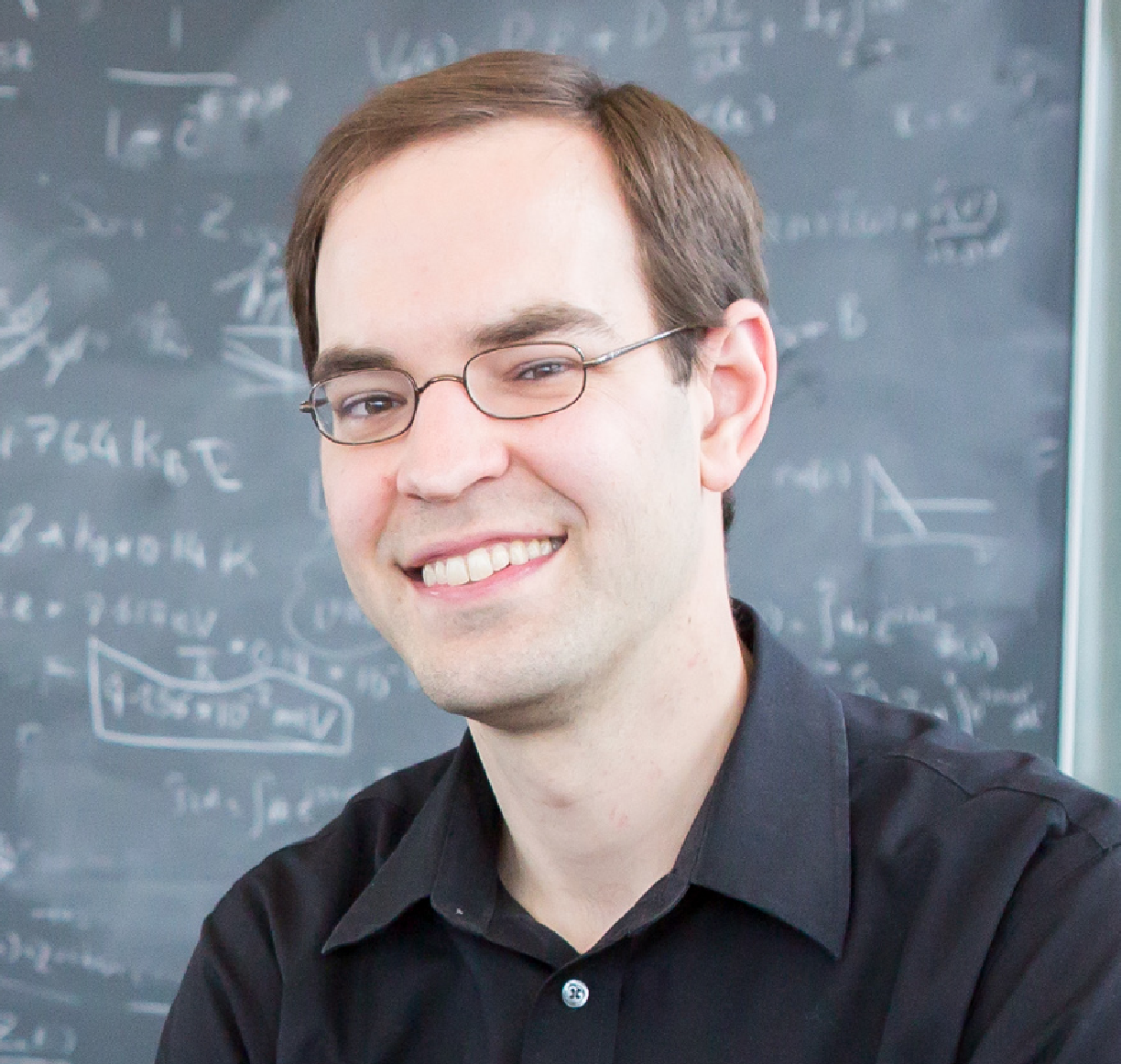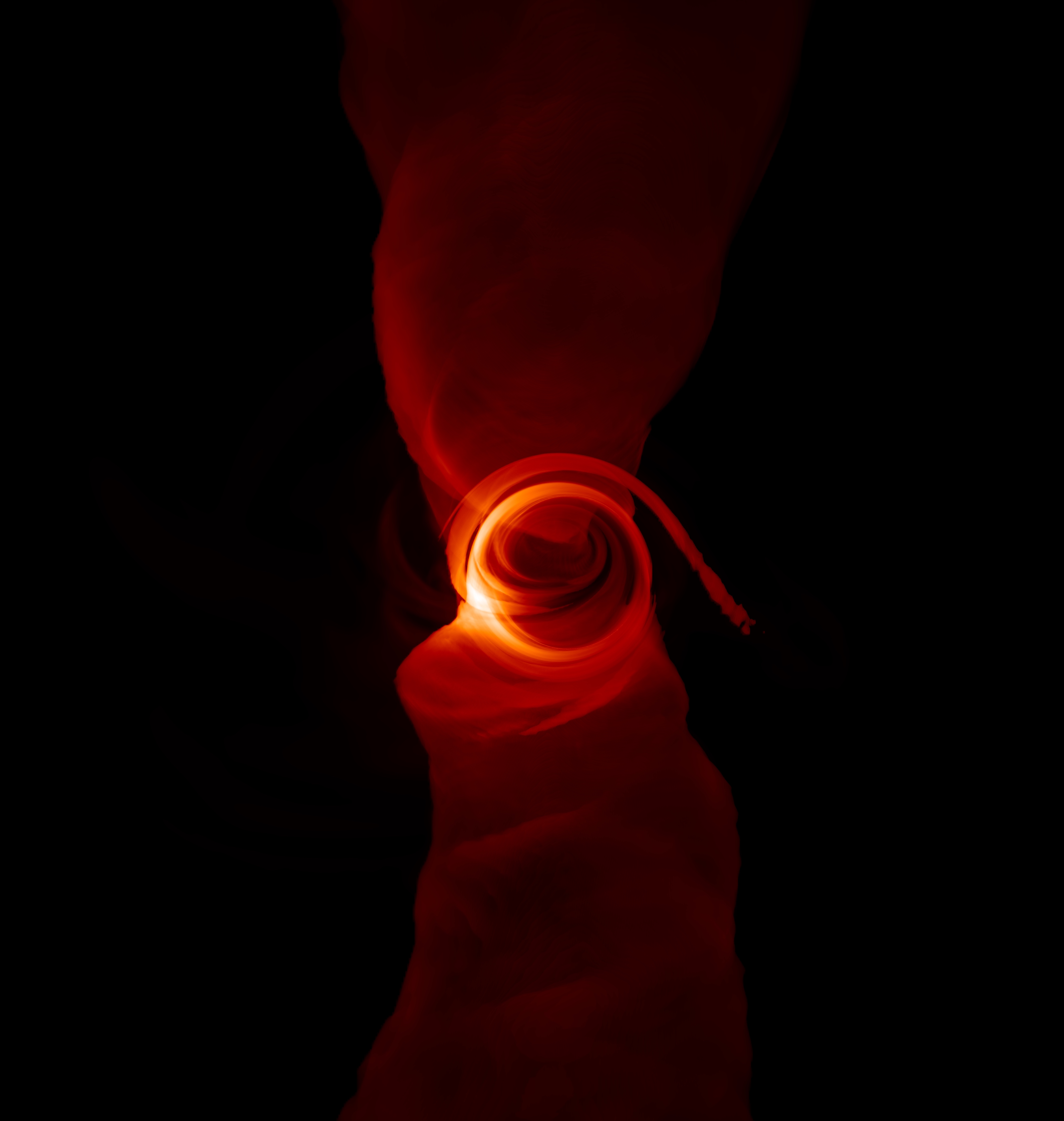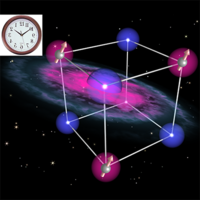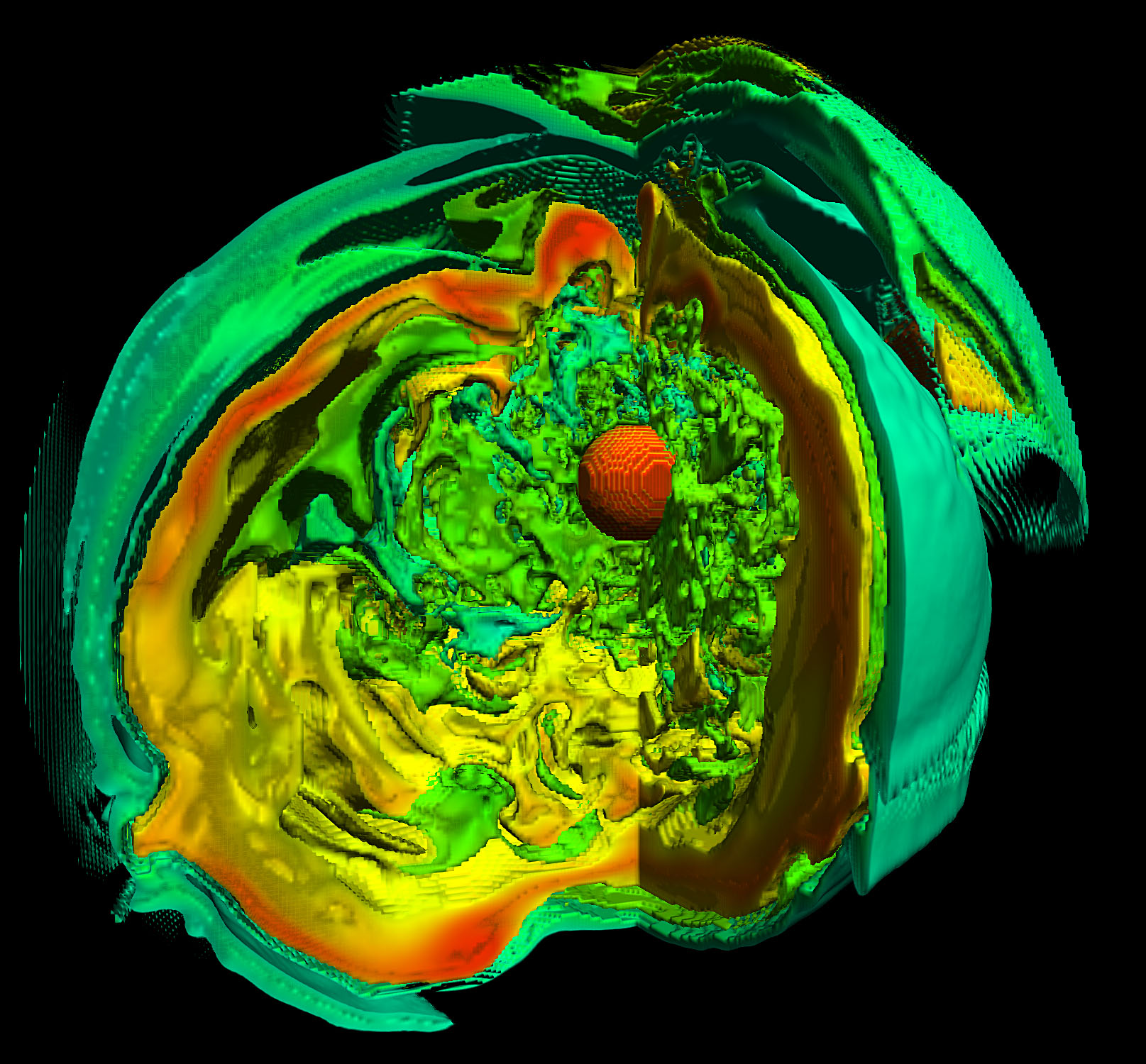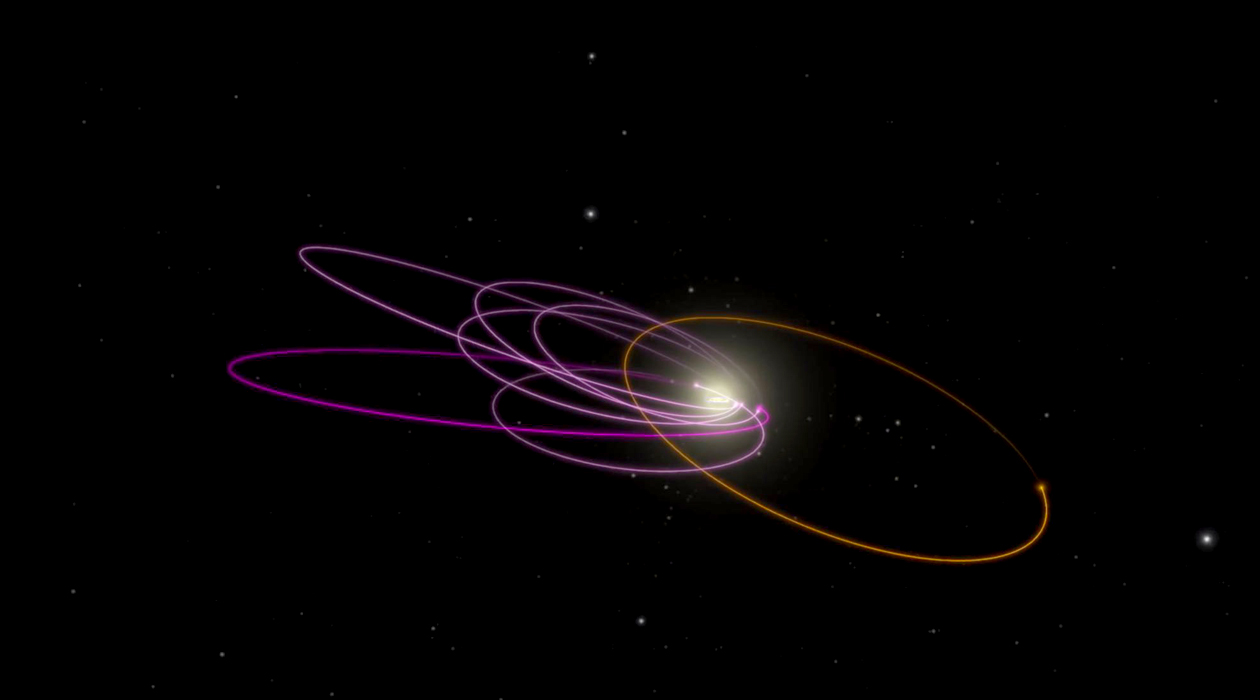 |
 |
 |
 |
 |
 |
 |
 |
 |
 |
 |
 |
|
Talks & Events
|
Colloquia: 2016
New Frontiers in Simulating Black Hole Accretion and Jets Black holes are responsible for a wide variety of astrophysical phenomena. They devour stars, eject relativistic jets, affect star formation and galaxy evolution, and enrich the Universe with heavy elements. In the next several years, the Event Horizon Telescope will produce resolved images of infalling gas and jets on the event horizon scale that promise to revolutionize our understanding of black hole physics. However, until recently, no first-principles models to quantitatively interpret these observations existed. I will present the first such models, the simulated spectra and images, and the constraints on the near event horizon physics coming from the comparison to the observations of the supermassive black hole at the center of our galaxy. I will then use simulations to constrain black hole physics in several other astrophysical contexts. I will finish by making connections to my future research plans. Searching for Dark Matter With Bubble Chambers PDF | Video Development of bubble chamber detectors for WIMP dark matter was pioneered at KICP in the early 2000’s. In the intervening years, we scaled the technology from the initial test-tube sized detectors operated in the basement of the LASR building to a 60 kg chamber now installed 2-km underground at SNOLAB. I will review the history of these developments and the most recent results from the PICO-2L and PICO-60 experiments. The Universe's most extreme star-forming galaxies Dusty star-forming galaxies host the most intense stellar nurseries in the Universe. Their unusual characteristics (SFRs=200-2000Msun/yr) pose a unique challenge for cosmological simulations and galaxy formation theory, particularly at early times. Although rare today, they were factors of 1000 times more prevalent at z~2-5, contributing significantly to the buildup of the Universe's stellar mass and the formation of high-mass galaxies. However, an ongoing debate lingers as to their evolutionary origins at high-redshift, whether or not they are triggered by major mergers of gas-rich disk galaxies, or if they are solitary galaxies continually fed pristine gas from the intergalactic medium. Observational evidence has been mixed over recent years; some studies clearly point to chaotic kinematic histories and fast gas depletion times (~<100Myr), while other work may demonstrate secular (though active) disks can sustain high star-formation rates over long periods of time. Similarly, some works argue such extreme star-formers contribute very little to cosmic star-formation, while others find quite the opposite. Furthermore, their presence in early protoclusters, only revealed quite recently, pose intriguing questions regarding the collapse of large scale structure. I will discuss some of the latest observational programs dedicated to understanding their origins and frequency at early times, their context in the cosmic web, and future long-term observing campaigns that will reveal their relationship to `normal’ galaxies, thus teaching us valuable lessons on the physical mechanisms of galaxy growth and the collapse of large scale structure in an evolving Universe. Quantum Twists of Space: Exotic Rotational Correlations from Quantum Geometry, Their Effects on Interferometer Signals, and Their Connection with Cosmic Acceleration PDF | Video The talk will review theoretical arguments that if space and time emerge from a quantum system at the Planck scale, there should be nonlocal exotic quantum correlations of positions of massive bodies, even on scales much larger than the Planck length. In relational theories with no fixed background space, these could take the form of rotational quantum fluctuations in the inertial frame. Basic quantum principles are used to derive their effect on correlations in the signals of interferometers. An experimental test is proposed, based on a reconfiguration of the Fermilab Holometer. It is conjectured that entanglement of these rotational correlations with the Standard Model vacuum could explain the value of the cosmological constant in terms of known scales of physics. IceCube: The Discovery of High-Energy Cosmic Neutrinos The IceCube project has transformed one cubic kilometer of natural Antarctic ice into a neutrino detector. The instrument detects more than 100,000 neutrinos per year in the GeV to PeV energy range. Among these, we have recently isolated a flux of high-energy cosmic neutrinos. The high cosmic neutrino flux observed indicates that a significant fraction of the radiation in the non-thermal universe, powered by compact objects from neutron stars to supermassive black holes, is generated by proton accelerators. We will discuss the IceCube instrument, the analysis of the data, and the significance of the discovery of cosmic neutrinos. Improved Limits from the Large Underground Xenon Dark Matter Experiment PDF | Video A wealth of astrophysical research supports the existence of dark matter in the universe, yet the exact identity and nature of this unknown particle remain elusive. The Large Underground Xenon (LUX) dark matter search is a 370-kg xenon-based time projection chamber (TPC) that operates by detecting light and ionization signals from particles incident upon a xenon target. With the 2013 report of the world’s first sub-zeptobarn spin-independent WIMP-nucleon cross section limit, the LUX (Large Underground Xenon) experiment emerged as a frontrunner in the field of dark matter direct detection. In December 2015, LUX released an updated analysis of its 2013 dataset with increased detector exposure, updates to the background model, upgraded event reconstruction algorithms, and novel calibrations leading to an overall 23% increase in sensitivity for high-mass WIMPs and even more significant improvements for low-mass WIMPs. This talk details the design of the LUX experiment and reviews the analysis and reanalysis of the 2013 dataset leading to the world’s most stringent constraints on spin-independent WIMP-nucleon scattering for WIMPs above mass 4 GeV. Two studies in planetary dynamics: (i) Impact seasons on Mars, (ii) The mass function of planets in the Galaxy I will present results of new calculations of the asteroidal impact flux on Mars. Mars' orbit is significantly eccentric and the planet orbits near the inner edge of the asteroid belt where the space density of asteroids has a large radial gradient. The correlated secular dynamics of Mars and the asteroids plays a significant role in modulating the impact flux on this planet. At the present epoch, this leads to a large variation -- of about a factor of three -- in the impact flux when Mars is near aphelion versus perihelion; significantly, the integrated annual impact flux is lower than would be expected in the absence of correlated secular dynamics. The second part of the talk will describe some deductions about the planet mass function from the observational data of exoplanets and theoretical considerations of long term stability. I will describe analysis of the observational data from the Kepler space mission which indicates that planetary orbital separations have an approximately log-normal distribution. Adopting some plausible ansatzs for the dynamical stability of N-planet systems to relate orbital separations to planet masses, it appears that the planet mass function is peaked in logarithm of mass, with the most probable value of log m/M⊕ ∼ (0.6 − 1.0); a modest extrapolation indicates that Earth mass planets are about ~1000 times more common than Jupiter mass planets, and that the most common planets in the Galaxy may be of lunar-to-Mars mass. New Approaches to Dark Matter PDF | Video In this talk I will discuss a novel theory of superfluid dark matter. The scenario matches the predictions of the LambdaCDM model on cosmological scales while simultaneously reproducing the MOdified Newtonian Dynamics (MOND) empirical success on galactic scales. The dark matter and MOND components have a common origin, as different phases of a single underlying substance. This is achieved through the rich and well-studied physics of superfluidity. The framework naturally distinguishes between galaxies (where MOND is successful) and galaxy clusters (where MOND is not): due to the higher velocity dispersion in clusters, and correspondingly higher temperature, the DM in clusters is either in a mixture of superfluid and normal phases, or fully in the normal phase. The model makes various observational predictions that distinguishes it from both LambdaCDM and standard MOND. In the last part of the talk, I will discuss an on-going attempt at explaining cosmic acceleration as yet another manifestation of dark matter superfluidity. Stellar rotation and exoplanets obliquity Spots on the stellar rotating surface can produce periodic brightness modulation that varies with the stellar rotational period. The Kepler space mission observed more than 150,000 stars continuously for more than four years, producing unprecedentedly precise light curves. We used this data gold mine to derive the rotational periods of more than 30,000 stars. About a thousand of the Kepler stars with derived rotational periods have been found to have planets orbiting around them. We use this sample and the derived amplitudes of the stellar modulation in particular, to infer some evidence for the star-planet obliquity - the angle between the stellar spin axis and the orbital planetary angular momentum of a planet. Previous studies found two populations of hot Jupiters - one around cool stars with orbits well-aligned with the stellar rotational axes, and the other around hot stars with isotropic distribution of obliquities, including planets with retrograde motion. We will show surprising statistical evidence that supports these findings. We will also discuss whether the amplitudes of the cool stars with planets depend on the planetary orbital periods, a dependence that might have some implications for the formation of short-period planetary formation. Global Radiation MHD Simulations of Black Hole Accretion Disks The inner regions of accretion flows in luminous sources such as AGN and X-ray binaries are radiation dominated. In the case of AGN, radiation and winds produced by such flows are thought to be an important feedback mechanism during galaxy formation in massive halos. I present new results from numerical studies of the magnetohydrodynamics of accretion this regime. These calculations use numerical methods based on a formal solution of the time-dependent radiation transfer equation, eliminating the need for approximate closures. We find that turbulent transport of radiation energy can be a significant contribution to the cooling rate in the disk, and this changes the global properties of the flow compared to standard slim-disk models. We describe new work to extend our calculations to full general relativity, in order to follow the dynamics in the innermost regions of the disk. Probing the Cosmic Dawn and the Epoch of Reionization with the 21cm Hydrogen Line Measurements of the cosmic microwave background at redshift z ~ 1100 give us information about the initial density fluctuations that seeded subsequent gravitational collapse and structure formation. Observations of galaxies and clusters at z <~ 7 give us information about the outcome of this structure formation. Between those redshifts lies a modern frontier of cosmology - the cosmic dawn that marked the formation of the first stars and galaxies and the deionization of the intergalactic medium. Direct observations of this phase of the universe's history are just beginning. A particularly promising technique is that of mapping hydrogen structures using the redshifted 21cm radio line. Several recently completed low frequency radio arrays are now operating and providing us with an early glimpse into the Epoch of Rionization. Building upon these results a next generation instrument, the Hydrogen Epoch of Reionization Array (HERA) is beginning construction. HERA will be significantly more capable, and presents interesting opportunities and challenges. The Dynamic Last Years in the Lives of Massive Stars In the last few years of the lives of massive stars, fusion in the core of the star produces a nuclear power that greatly exceeds the Eddington luminosity. This drives vigorous convection in numerous core and shell burning phases. I describe the surprising effect that waves excited by such convection can have on the properties of massive stars in the years leading up to core collapse. Wave transport of energy into the stellar envelope can power prodigious mass loss in the last years of stellar evolution. Angular momentum transport by waves excited during shell burning phases may well determine the angular momentum of the pre-supernova core, setting the birth spins of compact objects. WIMPs taking selfies: the DAMIC experiment at SNOLAB PDF | Video The DAMIC (Dark MAtter In CCDs) experiment employs the bulk silicon of ~mm-thick charge-coupled devices (CCDs) to detect coherent elastic scattering of Weakly-Interacting Massive Particles (WIMPs) - putative yet-to-be-discovered particles which may explain the dark matter in the universe. This novel technique features an unprecedentedly low energy threshold (few tens of eVee) for the detection of nuclear recoils, providing optimal sensitivity for low mass WIMPs (< 10 GeV). In addition, the spatial resolution of the CCDs, unique amongst dark matter detectors, provides powerful methods to identify and mitigate environmental and cosmogenic backgrounds. I will show recent results from DAMIC R&D data which demonstrate the potential of the CCD technology for WIMP detectors and first images from DAMIC100, a 100 g detector with 18 CCDs under installation at SNOLAB. A data-driven model of stars There is a lot of knowledge built in to our physical models of stars. But there is even more information in the sum total of all the data ever taken of stars (tens of thousands of pixels of spectral data on many hundreds of thousands of targets). The Cannon (named after Annie) uses a small amount of physical modeling and a huge amount of data to build very precise, predictive, probabilistic models of stellar spectra. I show that these data-driven models can be used to obtain extremely precise measurements of stellar parameters and detailed chemical abundances, substantially more precise even than the physical models used to generate "ground truth" inputs. Indeed, we believe that The Cannon working on SDSS-APOGEE data is delivering more precise chemical abundance measurements than any previous method for the analysis of stellar spectra. These results have implications for studies of exoplanets (which I won't discuss) and the Milky Way (which I might). Work in collaboration with Melissa Ness (MPIA), Andrew R. Casey (Cambridge), Anna Y. Q. Ho (Caltech) and Hans-Walter Rix (MPIA). Results from the first year of the HAWC Gamma Ray Observatory PDF | Video The High Altitude Water Cherenkov (HAWC) Gamma-ray Observatory in the high mountains of Mexico was completed in March of 2015 and is now giving us a new view of the TeV sky. HAWC is 15 times more sensitive than the previous generation of widefield EAS gamma-ray instruments and is able to detect the Crab nebula at >6σ with each daily transit. In our first year of operation, HAWC has a 5σ detection sensitivity for a source of ~50mCrab. Unlike Imaging Atmospheric Cherenkov Telescopes (IACTs), HAWC operates 24hrs/day with over a 95% on-time and observes the entire overhead sky (~2sr). HAWC’s peak energy sensitivity is 2-10 TeV which is ~10x higher than IACTs such as VERITAS and HESS, which makes their observations quite complementary. This talk will present results from the first year of HAWC data including our study of the galactic plane including new sources not yet detected by IACTs as well as spectra and morphology of bright sources. In addition, results of our monitoring of transient AGN will be presented. The next frontier of Massive Galaxies and Quasars at the Cosmic Dawn I will discuss recent progress in cosmological hydrodynamic simulations of galaxy formation at unprecedented volumes and resolution. I will focus on predictions for the first quasars and their host galaxies and their contribution to reionization from the BlueTides simulation. BlueTides is a uniquely large volume and high resolution simulation of the high redshift universe: with 0.7 trillion particles in a volume half a gigaparsec on a side. This is the first simulation large enough to resolve the relevant scales relevant to the formation of the first large galaxies and quasars. These massive objects at high redshifts will be investigated with the next generation telescopes (Euclid, JWST and WFIRST). A single prolific r-process event preserved in an ultra-faint dwarf galaxy The heaviest elements in the periodic table are synthesized through the r-process, but the astrophysical site for r-process nucleosynthesis is still unknown. The major current candidates are ordinary core-collapse supernovae and neutron star merger. Ancient, metal-poor ultra-faint dwarf galaxies contain a simple fossil record of early chemical enrichment that provides the means to study clean signatures of nucleosynthesis events, and thus, can yield unique information on the origin of these processes. Previously, extremely low levels of neutron-capture elements were found in the metal-poor stars in ultra-faint dwarf galaxies which supported supernovae as the r-process site. Based on Magellan/MIKE high-resolution spectroscopy, we have determined chemical abundances of nine stars in the recently discovered ultra-faint dwarf Reticulum II. Seven stars display extremely enhanced r-process abundances, comparable only to the most extreme r-process enhanced metal-poor stars found in the Milky Way's halo. The enhancement is also 2-3 orders of magnitude higher than that of stars in any of the other ultra-faint dwarfs. This implies the neutron-capture r-process material in Reticulum II was synthesized in a single prolific event that is incompatible with r-process yields from ordinary core-collapse supernovae but consistent with that of a neutron star merger. This would be the first signature of a neutron star merger in the early universe which holds the key to finally identifying the r-process production site. Furthermore, such a single r-process event is a uniquely stringent constraint on the metal mixing and star formation history of this ultra-faint dwarf galaxy. (Alex Ji, Anna Frebel, Ani Chiti, Joshua Simon, 2016, Nature 531, 610, http://arxiv.org/abs/1512.01558) Towards the identification of Earth-like worlds with MAROON-X Exoplanet surveys have recently progressed to the point of discovering small, potentially terrestrial planets orbiting in circumstellar habitable zones. Assessing the true degree of habitability of these worlds requires gaining knowledge of both their bulk and atmospheric properties. In this talk I will present my group's work to make advances on these subjects. I will begin wit an overview of recent results from exoplanet atmosphere observations with an emphasis on results from major program using the Hubble and Spitzer Space Telescopes. I will then summarize the development of MAROON-X, which is a high precision radial velocity spectrograph designed to measure the masses, and thus constrain the densities of potentially Earth-like worlds. I will describe how MAROON-X will be used in conjunction with future facilities like TESS, JWST, and the GMT to make the first credible searches for habitable environments beyond our Solar System. Planets around Binary Stars Planet formation and evolution around single stars seemed hard enough. Now gas giant planets have been found orbiting binary stars, bringing new challenges and opportunities regarding the theory of planet formation and evolution. First we will review the discoveries of a dozen planets by NASA's Kepler mission, using both the transit and the timing methods. These discoveries prove that planets can tiptoe near the instability zone; the specific dynamical arrangements offers clues into migration of planets through gaseous disks. Planets seem to avoid coming near very close binaries, which is a new data point relating to the dynamical history of such binaries. That some planets went unstable is very likely, and we consider the fate of such planets as well as observational signatures. The Dark Energy Survey and Gravitational Waves PDF | Video In this talk I present recent results of the Dark Energy Survey (DES) searches for optical counterparts to Gravitational Wave (GW) events detected by the LIGO/Virgo Collaboration. Our program achieved greater sensitivity than any other optical facility last year. For the second observing campaign (Fall/2016-Spring/2017) our goals are to either make a detection or establish significant constraints on optical emission from such events. DES is the greatest optical imaging survey yet, aiming at percent-level precision measurements of cosmological parameters from a combination of probes such as type Ia supernovae, galaxy clusters, and weak gravitational lensing. These probes are limited by astrophysical systematics and new independent methods are required in order to beat systematic effects down to sub-percent levels. Standard sirens, events for which distances are determined from their gravitational wave signal, are one possible new method to meet that challenge. Our program will potentially have a great impact in our field by exploring this possibility from the observational perspective. In this talk I will also briefly discuss this exciting prospect for future observing campaigns. Protostellar Disks: Formation and Polarization Circumstellar disks play a central role in the formation of both stars and planets, but how they form remains uncertain. Once thought to be a simple consequence of the conservation of angular momentum during the hydrodynamic collapse of molecular cloud cores, disk formation is now known to be complicated by the presence of a dynamically important magnetic field, which can strongly brake the rotation. Indeed, both analytic arguments and numerical simulations have shown that protostellar disk formation is suppressed in the ideal MHD limit for the observed level of cloud core magnetization. In the first part of the talk, I will discuss the physical reason for this so-called "magnetic braking catastrophe" in disk formation, and review possible ways to avert it, including non-ideal MHD effects, misalignment between the magnetic field and rotation axis, and turbulence. In the second part, I will discuss the millimeter polarization recently detected in the disk of the famous young stellar object HL Tau, focusing on possible contribution from scattering by large dust grains. If confirmed, the dust scattering-induced polarization would open a new window on grain growth, the crucial first step toward the formation of planetesimals and eventually planets. The field of disk polarization is poised for rapid growth in the ALMA era. The First Four Months of Gravitational Wave Astronomy PDF | Video On September 14, 2015 LIGO made the first direct detection of gravitational waves, marking the beginning of gravitational wave astronomy. The LIGO instruments continued to take data over the next four months, completing their first observing run on January 19, 2016 with 51.5 days of coincident data. I will present results from advanced LIGO's first four months of operation, and what they have taught us thus far. Black Hole Physics with the Event Horizon Telescope The Event Horizon Telescope is an experiment that is being performed on a large and ever-increasing array of radio telescopes that span the Earth from Hawaii to Chile and from the South Pole to Arizona. When data will be taken with the full array, it will image the event horizons of the supermassive black hole at the center of our Galaxy, Sagittarius A*, and the black hole at the center of M87, with an unprecedented 10 microarcssecond resolution. This will allow us to take the first ever pictures of black holes at 1.3 and 0.85 mm wavelengths and look for the shadow that is a direct evidence for a black hole predicted by the theory of General Relativity. In addition, the Event Horizon Telescope will also enable us to study the process by which black holes accrete matter and grow in mass. I will discuss the theoretical developments in simulating the properties of the black hole accretion flows and their expected images using state-of-the-art algorithms and high performance computing. Interpreting the upcoming observations within this theoretical framework will open new horizons in black hole astrophysics. New Directions in Searching for the Dark Universe PDF | Video Observational bounds currently permit the existence of a large number of dark matter candidates, ranging from ultra-light axions with masses ~ 10^(-22) eV to MACHOs with mass as large as 10^(24) gm. It is important to develop experimental methods to constrain this vast range of parameters. In this talk, I will describe new experimental methods to probe a wide variety of dark matter candidates, ranging from ultra-light axions with masses ~ 10^(-22) eV to light WIMPs with mass in the keV - GeV range. A variety of precision measurement technologies such as optical/atomic interferometry and SQUID magnetometry can be applied to search for these particles. I will also discuss methods to search for the direction of the nuclear recoil induced by conventional WIMP scattering in detectors with solid state densities. These directional detectors may enable probes of conventional WIMP dark matter beyond the solar neutrino floor. Where are we in the hunt for the core collapse supernova explosion mechanism(s)? Fifty years have passed since the first simulations of core collapse supernovae were performed. Definitive simulations that assumed spherical symmetry have been completed, and laid the foundation for simulations in two spatial dimensions that assume axial symmetry and three spatial dimensions with no imposed symmetries. In the past decade, axially symmetric simulations of core collapse supernovae have matured rapidly, and three-dimensional simulations have been initiated in earnest. Progress has in fact been exponential given the derived understanding from past work and the availability of increasing computational capability. I will discuss what has been illuminated as central to the explosion mechanism to date, the current state of the community's simulation efforts, and the requirements and challenges that lie ahead in order to perform definitive three-dimensional simulations that will pin down the recipe for explosion and provide a predictive capability for all of the observables associated with core collapse supernovae. The timeliness of this progress and future push are highlighted by the recent birth of gravitational wave astronomy. The next Galactic supernova promises a wealth of information for supernova modelers and members of the gravitational wave, neutrino, and nuclear physics communities. Planet Nine from Outer Space At the outskirts of the solar system, beyond the orbit of Neptune, liesan expansive field of icy debris known as the Kuiper belt. The orbits of the individual asteroid-like bodies within the Kuiper belt trace out highly elongated elliptical paths, and require hundreds to thousands of years to complete a single revolution around the Sun. Although the majority of the Kuiper belt's dynamical structure can be understood within the framework of the known eight-planet solar system, bodies with orbitalperiods longer than about 4,000 years exhibit a peculiar orbital alignment that eludes explanation. What sculpts this alignment and how is it preserved? In this talk, I will argue that the observed clustering of Kuiperbelt orbits can be maintained by a distant, eccentric, Neptune-like planet, whose orbit lies in approximately the same plane as those of the distant Kuiper belt objects, but is anti-aligned with respect to those of the small bodies. In addition to accounting for the observed grouping of orbits, the existence of such a planet naturally explains other, seemingly unrelated dynamical features of the solar system. Increasing Accuracy and Increasing Tension in H0 PDF | Video The accuracy in direct measurement of distances to galaxies has continued to improve dramatically over the past decade. Local measurements of the Hubble constant based on Hubble Space Telescope observations of astrophysical standard candles -- Cepheids and Type Ia supernovae -- have converged on a value of about 73 km/sec/Mpc with an uncertainty of 2-3%. At the same time, estimates assuming a Lambda-CDM standard model and fitting highly precise measurements of cosmic microwave background fluctuations have yielded a value of Ho = 67 km/sec/Mpc. The two methods disagree at approximately the 3-sigma level. The reason for this discrepancy is not understood at present, and new data have only increased the tension. If real, the disagreement could be signaling missing physics in the standard model; for example, additional dark radiation. Major efforts are ongoing to improve further the accuracy in the local measurements, including developing other techniques to test the Cepheid distance scale. In the near future JWST and Gaia will provide a path to measuring Ho to 1%, comparable to the precision in CMB measurements. |


